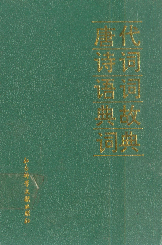唐代诗词语词典故词典
顾国瑞、陆尊梧主编。社会科学文献出版社1992年12月出版。收录唐、五代诗词中的语词、典故18000余条,分为语词和典故两大部分,每部分再按音序编排。每条词目之后,均有注音、释义,并列举例句,指明出处。书末附“词目笔画索引”。

主要责任者: 顾国瑞,陆尊梧
责任方式: 主编
出版者: 社会科学文献出版社
出版地: 北京
字数: 1800 千字
页码: 3-1468
开本: 32
装帧: 精
语种:中
定价:25.00
出版时间:1992-12
丛书多卷书否:否
书目简介:本册工具书共收录19556条词条。
被引频次:33